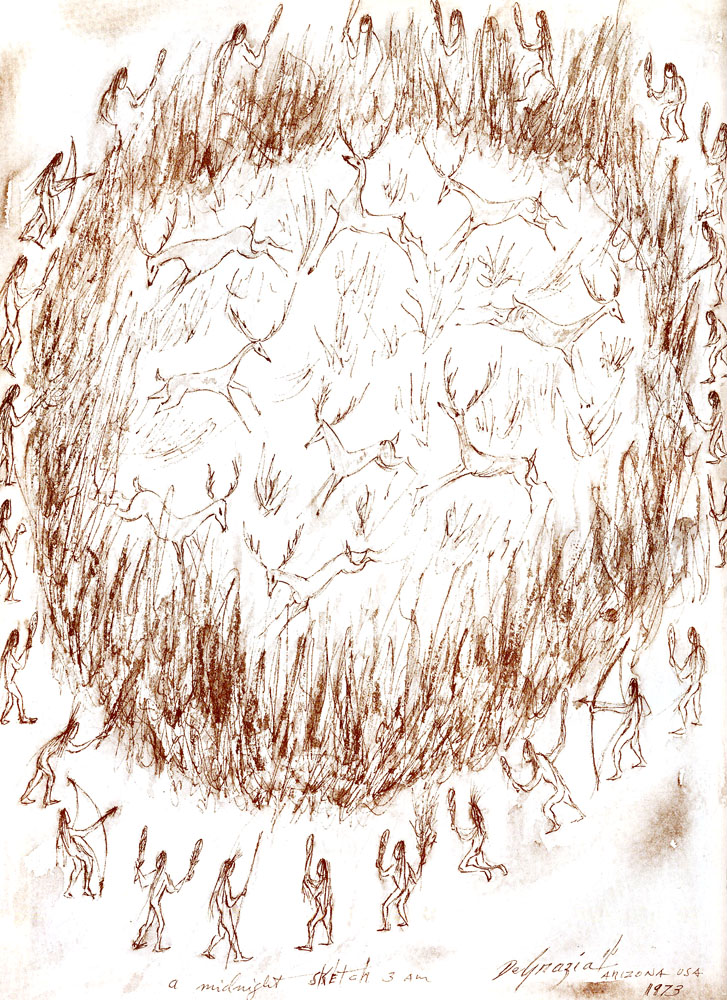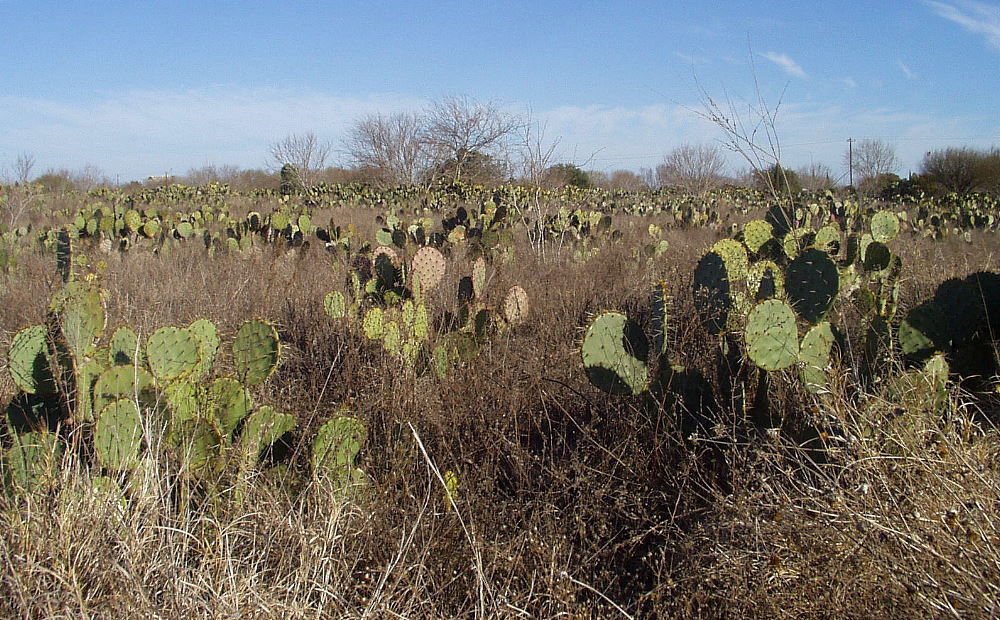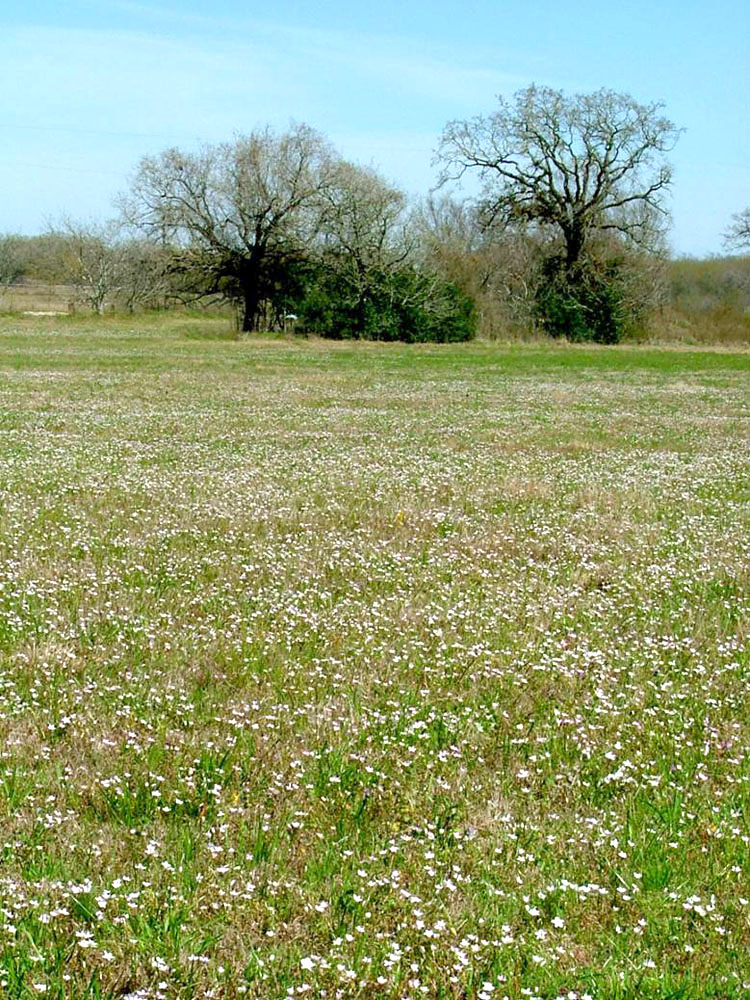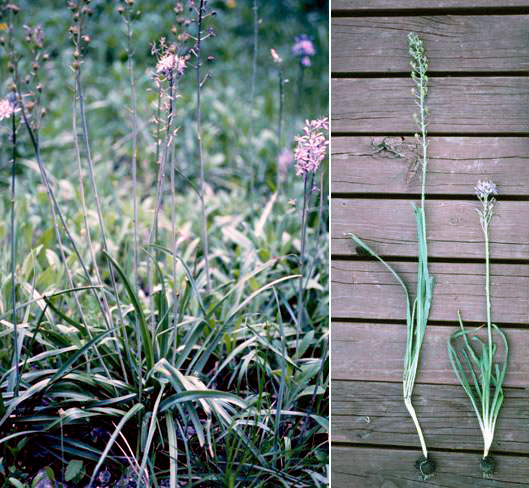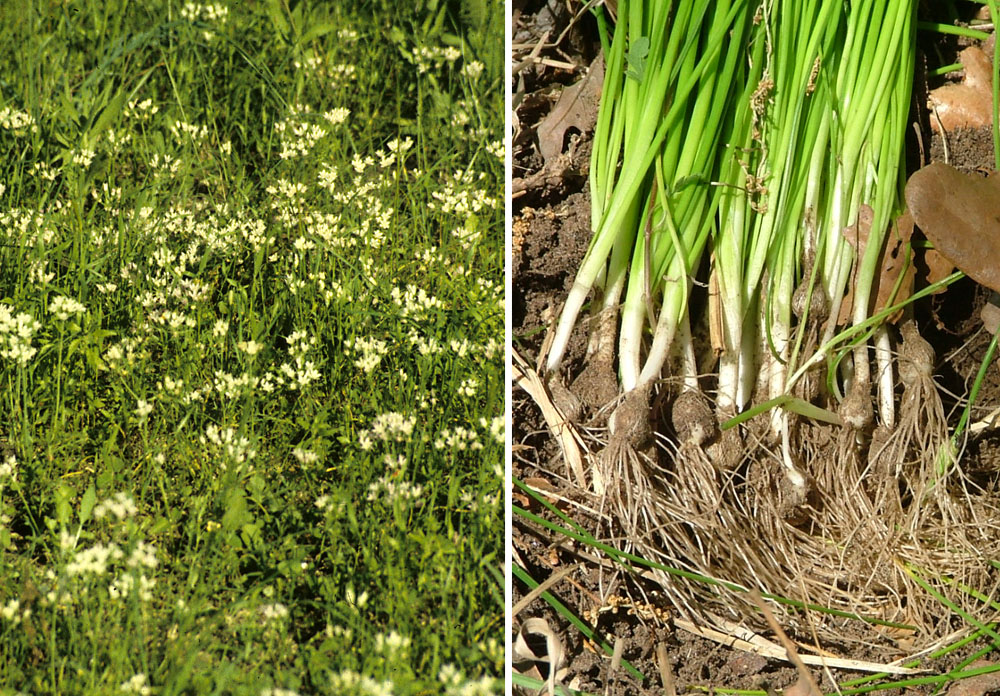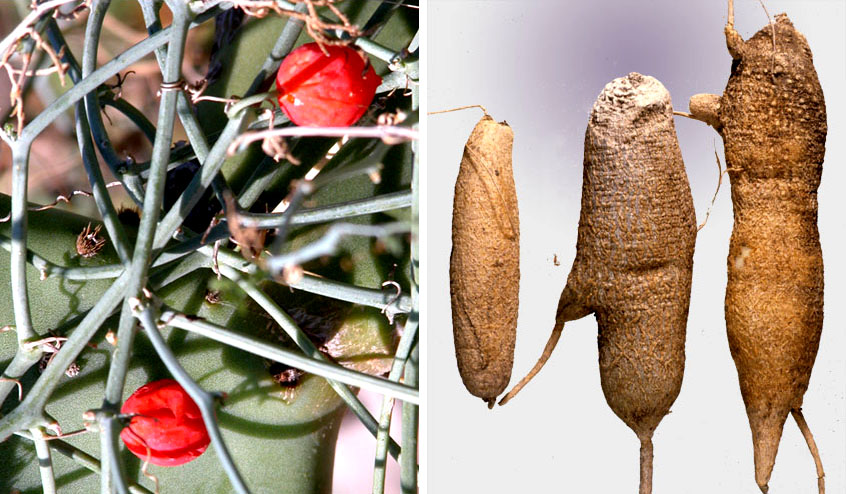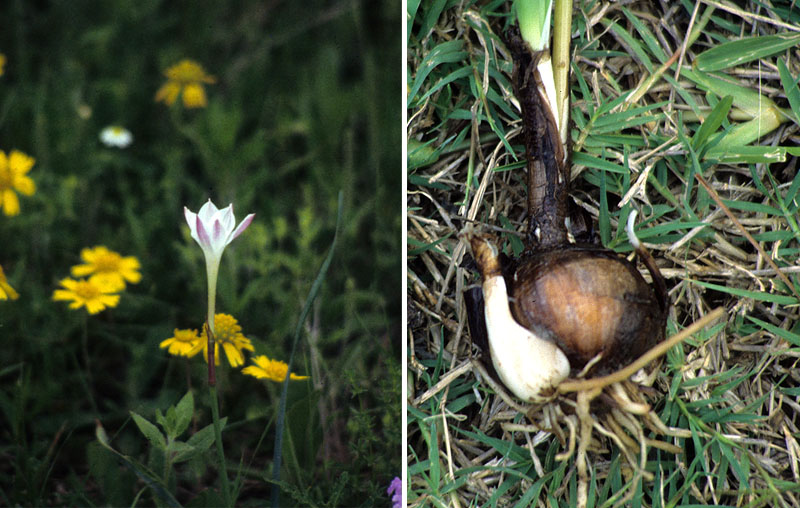Roots and Fruits of Inland Foodways
Route of Cabeza de Vaca among Inland groups. At right, reconstructed scene of native peoples baking cactus pads, adapted from painting by Nola Davis. Courtesy Texas Parks and Wildlife Department. |
 |
Diverse FoodwaysIt was when Cabeza de Vaca, Dorantes, Castillo, and Estevan were in the custody of mainland groups on the outer Gulf Coastal Plain that they became acquainted with more diverse foodways of the South Texas heartland: gathering and baking nopalitos and tunas as well as digging and baking endemic geophytes. During the summer, prickly pear products provided the bulk of the subsistence for these groups. For most of the winter, they relied on roots, some of which were few in number and difficult to dig; others were reported as being bitter or causing flatulence. Mainland groups, including those known as the Yguazes and Mariames lived in mat-covered dwellings similar to those used by coastal-oriented groups. So too did the Avavares and other groups who inhabited the inner Gulf Coastal Plain. In response to the local availability of diverse food supplies, these rancherías were moved from place to place, within a given resource area, as often as every two or three days. Residential moves among many fishing-oriented coastal groups were much less frequent given the comparative productivity of fishing grounds and shellfish beds within their homelands. The Yguazes, Mariames, and neighboring groups often used surround fires to take deer, occasionally 200-300 at a time, from along the rivers and the adjacent savannahs. On one occasion, 60 hunters reportedly took 500 deer in eight days. Often, however, none were killed. Mice were taken from along the rivers as well where they occurred in “great abundance.” According to Oviedo, “All of this is little [in amount] because they walk along the river the whole of winter up and down, and down and up, never stopping searching for food.” |
|
 |
While deer seem to have been abundant on the Gulf Coastal Plain, at least in some places and at some times of the year, bison or “cows” in Cabeza de Vaca´s parlance were rare sights indeed. "Cows come this far and I have seen them three times and have eaten of them and I think they are about the size of those of Spain. They have small horns, like Moorish cattle, and very long hair, wooly [merino] like a rug [bernia]. Some are dark brown and others black and in my opinion they have better and richer flesh than those from here [Spain?]. From those that are not as large the Indians make robes [mantas] to cover themselves and from the large ones they make shoes and round shields [rodellas]. These [the bison] come from toward the north…" -Cabeza de Vaca (Krieger 2002:196). Fish were a key resource on the outer Gulf Coastal Plain during the spring, if and when the rivers flooded. Sometime during the late summer, the mainland groups, along with the Fig People from farther south along the coast, moved to extensive and productive tuna grounds located some 30-40 miles south of San Antonio (according to Krieger) for 50-60 days. It was probably the most enjoyable time of the year and the people took advantage of the opportunity to eat their fill of sweet tunas “day and night” and enjoy side-dishes of land snails. |
|
 |
|
Prickly Pear Grounds There has been considerable debate about the location of the prickly-pear tuna grounds first visited by Cabeza de Vaca and his fellow trekkers. As noted, Alex Krieger places the major tuna ground visited by Cabeza de Vaca and his traveling companions during the initial phase of their South Texas sojourn some 30-40 miles south of San Antonio, in southern Atascosa and northern McMullen counties. Thomas N. Campbell, who was also very knowledgeable about Cabeza de Vaca’s route, located this particular tuna ground about 100 miles south of San Antonio, in central Jim Wells County and vicinity. This location is also favored by many of today’s students of Cabeza de Vaca. Interestingly, Campbell’s location of choice corresponds with Krieger’s alternate location near Alice, Texas. Both Krieger and Campbell located the second major tuna ground—where the trekkers overwintered with the Avavares—a few miles south of the Nueces River in northern Webb and Duval counties. Regardless of where one places these tuna grounds, it is evident to anyone familiar with greater South Texas that prickly pear grows in abundance throughout much of the region. Cabeza de Vaca reported that the best of times for the region’s native people were when the sweet tunas ripened, as there was plenty for all and various bands gathered for the harvest and held trade fairs as well. He added that “there are many kinds of tunas and among them some are very good, although to me they all seemed so and hunger never gave me time to choose, nor to reflect on which were better.” Henri Joutel, an officer of the ill-fated French colony on near Matagorda Bay in the late 1600s was not as impressed as Cabeza de Vaca about the goodness of tuna; he noted only that “these fruits do not have much taste; they are in several shapes, sizes and colors.” Botanists today also distinguish several species and varieties of prickly pear that grow in the region. As discussed in later, different parts of the prickly pear plant were eaten at different times of the year. In the springtime, the young pads or nopalitos (i.e., stems) were at their best. A ubiquitous presence of prickly pear pollen in human coprolites (dehydrated feces) recovered from rock shelters in the lower Pecos area indicates that the flowers, or more likely the flower buds, were relished as well. Green tunas, while perhaps not a favorite per se, were eaten regularly during the summer when food was otherwise quite scarce. It was, however, the sweet, ripe, purple-colored tunas that were clearly the favored foodstuff during the fall. In many cases, potable water was scarce at the tuna grounds, such that the trekkers and presumably their hunter-gatherer hosts quenched their thirst with the juice of the sweet fruit. The trekkers reported that they collected and drank juice from prickly-pear tuna in a “trench that we made in the earth” and that they did this “for lack of other vessels.” His comments about a “lack of other vessels” might well be taken as an indication that these particular Coahuiltecans did not make much use of pottery. Elsewhere in the text, however, he provides ample evidence for the presence of ceramic vessels among Coahuiltecan groups throughout South Texas. In reference to all of the groups with whom he was familiar, from Galveston Island to the middle Nueces River valley, he noted that they made a “drink” from leaves of a holly-like or live-oak-like shrub, he reported that “they roast it [leaves] in some vessels” and then they “fill the vessel with water and thus keep it over the fire and when it has boiled twice they pour it into a dish [vasija] and cool it with half a gourd.” This passage indicates that pottery vessels were in regular use at residential encampments, albeit not necessarily taken on logistical forays to gather ripe tuna. That pottery was in regular use along the coast is also implied by Cabeza de Vaca´s comment, mentioned earlier, about one of his men having stolen an olla from an Indian´s home on Galveston Island. There is abundant archeological evidence of native pottery along the coast, and it occurs inland across most of South Texas as well, albeit less abundantly. After the tuna season, the Yguazes and Mariames along with other mainland and inland groups in South Texas returned to their homeland along the lower reaches of the Guadalupe and San Antonio Rivers and vicinity where, in good years, they were able to subsist on pecans for two months. Pecans were often ground together with unidentified “little grains” but nothing in the accounts attests to cooking techniques. It is clear, however, that pecans were among regional staples wherever they grew in abundance. With the arrival of winter the root food season came into full swing. |
|
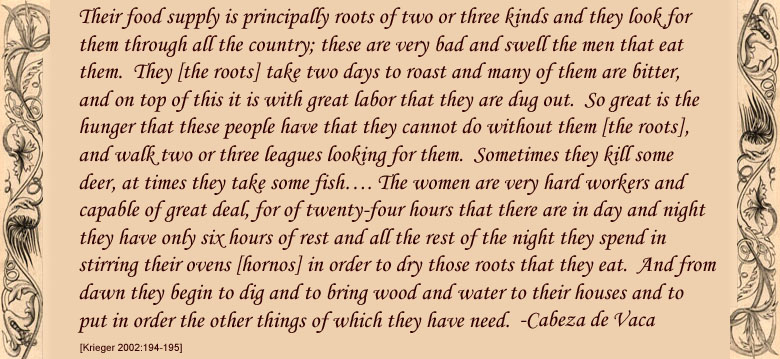 |

Native women digging plant bulbs in south Texas. Described as very hard workers by Cabeza de Vaca, the women likely knew the locations of the most prolific food-plant patches and could find food even in winter months when the above ground portions of the plants had died back and disintegrated. Cabeza de Vaca's observation that some areas appeared to have been trampled by cattle may, in fact, have been a dug-over root field. Drawing by Jack Johnson.
|
Identifying the Root FoodsIn spite of the obvious importance of root foods in aboriginal South Texas and vicinity, little attention has been given to determining which plants sustained the people there for much of the year. By drawing upon what is known about the distribution of and cooking techniques associated with geophytes on the Gulf Coastal Plain and elsewhere, it is certainly possible to eliminate some species and suggest others as likely candidates. It is also reasonable to assume that baking in an earth oven for two days required stone heating elements (i.e., hot rocks) to maintain high temperatures for prolonged periods and thereby render these as-yet-unidentified roots digestible. Some geophytes along with other foods, including nopalitos, shellfish, fish, and game animals, do not require prolonged baking and are readily cooked in rockless ovens and on/in open-air hearths. But many geophytes require extended baking. Agave and sotol, which were critical resources on the Edwards Plateau to the west, can be ruled out because they do not grow well, if at all, anywhere on the Gulf Coastal Plain north of the Rio Grande. Eastern camas or wild hyacinth (Camassia scilloides) is a potential candidate, and charred bulbs have been recovered from archeological sites as far south as along the San Marcos River. But two things argue against it being among the principal roots of South Texas: (1) San Antonio is at the extreme southeastern limit of its distribution; and (2) it becomes sweet, with a decidedly molasses taste, after being oven baked for two days. Oviedo wrote that the roots on which inland groups depended were “very few” and Cabeza de Vaca noted that women were compelled to walk miles from their villages to find enough to eat. Other things being equal, these statements would seem to mean that the roots were few and far between, deeply buried or encased in hard sediments. On the other hand, these comments may be among the figures of speech or perhaps testimonies to what “noblemen” considered unpleasant work. The point here is that for geophytes to have been seasonal staples for so many people over such a vast region implies that the effort was compensated by the return. Among the geophytes that grow in considerable abundance in South Texas are two lily-family plants: onions (Allium sp. ) and false garlic (Northoscordum bivalve). Charred bulbs from these plants have been recovered from the remains of earth ovens with rock heating elements at archeological sites in adjacent regions. These particular geophytes are likely to sustain long-term, systematic exploitation: (1) they grow abundantly in bottomlands and uplands; (2) they are readily dug from sandy or moist silty or clayey soils; and (3) root grounds are often in proximity to the raw materials necessary to prepare foods cooked in earth ovens with rock heating elements, namely cook-stone raw material, fuel, green-plant packing material, and water. Several species of onions grow in densities of 50 or more plants per square meter, as does false garlic. If onions were among the staples, however, we might well expect Cabeza de Vaca to have referred to them by name—cebolla—insofar as onions were probably used throughout Europe at that time and have a distinctive odor, as is known to anyone who has ever walked through a patch of wild onions. Moreover, onions baked for many hours are rendered somewhat sweet, certainly not bitter. I do not known whether their consumption in quantity would lead to flatulence, but “gas” is a well-known by product of baked western camas bulbs and camas, another lily-family plant, is closely related to onions. False garlic, in its raw state is odorless and has an acrid taste. From my own home-kitchen experiment, I know that after being baked for eight hours or so in an electric oven, false garlic bulbs, which are whitish in color, turn brownish and “sweeten up” somewhat, although most folks would probably say they remain rather bitter. As such, I count them among the prime contenders for the Cabeza de Vaca “bitter root award. " Rio Grande globeberry (Ibervillea tripartite), another contender, is a South Texas vine plant that takes its common name from the small round red to orange “melons” it yields, but it also produces a potato-like tuber. Globeberry meets the criteria of being difficult to extract from dry clayey sediment, of growing in low densities, compared to false garlic, and, based on my home-kitchen experiment, it becomes palatable albeit still substantially bitter after baking overnight in an electric oven. Accordingly, it too is among the “bitter-root” contenders, although I cannot attest to it digestive properties. Another contender of sorts, in terms of its low density in comparison to onions or false garlic, is rain lily (Cooperia drummondii). It grows throughout South Texas in sandy and clayey soils, often in patches of several plants per square meter. It produces sizable bulbs and is certainly bitter in its raw state. While it is sometimes included on lists of poisonous plants, its ostensible toxicity could well be rendered harmless by long-term baking. In any case, its charred remains have been recovered from archeological deposits in rock shelters along the lower Pecos River, as reported by archeologist and ethnobotanist Phil Dering. Wine cup (Callirhoe involucrata), in my opinion, is also a leading candidate for a place on the ticket for South Texas, winter-time geophytes. In places, wine cups certainly grow in high enough densities to have been a seasonal staple. Each plant has a carrot-size tap root, and often occur four to six per square meter. As with many geophytes, the root is largest and presumably most nutritious during the winter and early spring before the plant produces its showy flowers. |
|

